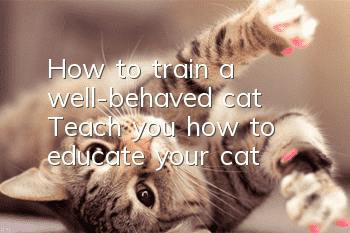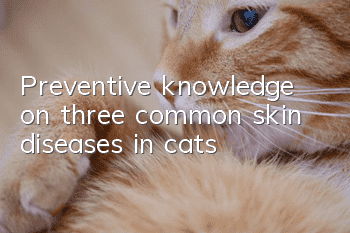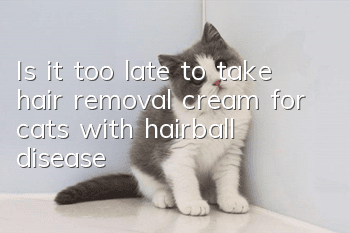How to train a well-behaved cat? Teach you how to educate your cat!

Ragdoll cat (detailed introduction)
How to train a well-behaved cat? Teach you how to educate your cat! Many people think that the cat in their home is not well-behaved because there is something wrong with the breed. Indeed, Cats of some breeds will show characteristics of the breed, such as liveliness, nervousness, etc. However, some cats can live well with us after artificial training.
1. Principles of cat training
Cats are talented, active, like to play, and are very curious about bugs, threads, and ropes. I have a strong interest in paper balls and leaves blowing in the wind, and I often fiddle with and play with these things. Usually, cats can instinctively make various interesting actions such as rolling, limbs in the air, standing upright, etc. when teased by their owners.
However, it is much more difficult to train cats to do some more complex movements than dogs. This is because cats are very independent and have an extremely stubborn character that does not want to be manipulated by others. Even if the owner doesn't let the cat do something it likes, it won't do anything if the owner doesn't like it. If the cat doesn't like something, it won't accept it even if it is forced to do it. In addition, cats are alert by nature and are easily afraid of bright lights and crowds of people, so it is more difficult for them to perform in public.
However, as long as you have patience and combine scientific methods, cats can still be tuned and trained in a short period of time. The completion of all cat behaviors is based on neural reflexes as its physiological basis. The so-called reflex activity is the process in which the body reacts through the activity of the nervous system after the body's receptors are stimulated by certain stimuli. For reflex activity to occur, there must be stimulation. Stimuli refer to those that can be sensed by the body's tissue cells and can cause certain reactions. Changing internal and external environmental factors. Such as tapping and pressing. Light, sound, temperature, etc. Cats have various sensitive receptors in their bodies, such as vision, hearing, smell, and various temperature, pain, and touch receptors in the skin. They can each sense different stimuli and convert these stimuli into neural excitation processes. When the excitement reaches the brain along the afferent nerves, the brain responds immediately and transmits instructions to the effectors (muscles, glands, etc.) through the efferent nerves, causing the effectors to take corresponding actions.
Animal reflexes can be divided into two categories: unconditioned reflexes and conditioned reflexes. Unconditioned reflex is an innate reflex that animals are born with and is the most basic and important reflex activity for animals to maintain life. For example, kittens will be able to suck milk and breathe when they are born. Stimuli that can cause unconditioned reflexes are called unconditioned stimuli, such as food, touch, tapping, etc. Conditioned reflexes are neural reflex activities that are gradually formed after an animal is born and adapts to the living environment during its life. It is acquired. This reflex is an advanced neurological activity that ensures a high degree of balance between the animal's body and the surrounding environment. It is a habit formed during the feeding and management process and various abilities developed through training. It is an individual-specific reflex activity.
2. Cat training methods
1.Force
Forcing refers to the use of mechanical stimulation and threatening commands to force the cat to complete actions accurately and smoothly. When training a cat to lie down, the trainer will put the cat down with his hands while giving the "lie down" command, forcing the cat to lie down. After repeating this several times, the cat will soon form a conditioned reflex to lie down. .
2. Induction
Induction refers to a method of inducing the cat to make actions using delicious food and the trainer's movements. For example, while giving the "come" command, the trainer shakes a piece of food that the cat likes in front of the cat, but does not give it to the cat to eat. While retreating, he keeps giving the "come" command. In this way, the cat will follow you due to the temptation of food, and will soon form a conditioned reflex. The induction method is most suitable for kittens.
3. Reward
Reward refers to the means taken to strengthen the cat’s correct actions or consolidate the initially formed conditioned reflex. Reward methods include food, caress and praise. Rewards and coercion must be used in combination to be effective. At the beginning, the cat should be forced to perform correct actions every time, and then rewards should be given immediately. As training progresses, rewards will be given after completing some complex movements. Only in this way can the effectiveness of rewards be fully utilized.
4. Punishment
Punishment is a method used to prevent cats from incorrect movements or abnormal behaviors, including reprimands, tapping on the head and neck, etc. The degree of punishment should be determined according to the specific situation and the cat's temperament. Do not hit the cat's head excessively or pull its tail forcefully to frighten it excessively. The use of punishment methods should also be minimized during training to prevent cats from feeling fearful and tired of training.
Training cats is not as simple as dogs. Cat training takes a relatively long time, so it requires continuous training from the owner.
- The cat suddenly became anorexic and became skin and bones
- What should I do if my cat’s nail clipping bleeds?
- Will pregnant cats become sleepy?
- How to deal with cat poop on your body
- Why do cats act like crazy after pooping?
- What should cats eat after pregnancy?
- Can feline coccidia be transmitted to humans?
- How much does a snowshoe cat cost? The source and price of snowshoe cats!
- Are there any side effects of taking catamine for a long time? Is it good for cats to take catamine?
- How to make a cat an excellent pick-up cat? Cat training!



